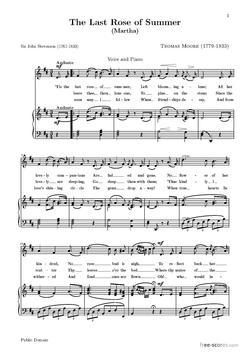夏天最后一朵玫瑰

《夏天最后一朵玫瑰》(英語:The Last Rose of Summer),又译夏日的最后一朵玫瑰等,是爱尔兰诗人托马斯·摩尔创作的一首诗。1805年,诗人在爱尔兰基尔肯尼郡的詹金斯顿城堡(Jenkinstown Castle)中创作了这首诗,并在1813年出版。这首诗可以以爱尔兰传统曲调《年轻人的梦》(Aisling an Óigfhear)演唱[1],这个曲调本身则是爱尔兰民歌搜集家爱德华·邦廷1792年在贝尔法斯特竖琴音乐节上记录下来的[2]。它在后世被贝多芬等音乐家广泛采用[3]。
文本内容
[编辑]
| 英语原文[4] | 汉语译文(廬隱译)[5] |
|---|---|
| 第一节 | |
'Tis the last rose of summer, |
那是夏天最后一朵玫瑰, |
| 第二节 | |
I'll not leave thee, thou lone one. |
你这孤独者,我将不让你 |
| 第三节 | |
So soon may I follow, |
当真挚的友谊萎谢了时, |
电影
[编辑]有多部电影作品的灵感来自这首诗,如1912年美国[6]、1920年英国[7]的同名默片。它还频繁地出现在其它一些影视作品中,如1939年电影《春闺三凤》中狄安娜·窦萍就演唱了这首诗[8]。
参考文献
[编辑]- ^ Walton's, editors. Ireland - The Songs Book 4. 1993.
- ^ Edward Bunting, A General Collection of the Ancient Irish Music (1796)
- ^ Axel Klein: "'All her lovely companions are faded and gone' – How The Last Rose of Summer Became Europe's Favourite Irish Melody" and its appendix, "Utilisations of 'The Last Rose of Summer', respectively 'The Groves of Blarney', by European Composers in the Nineteenth Century, in Chronological Order", in: Sarah McCleave & Brian Caraher (eds.): Thomas Moore and Romantic Inspiration. Poetry, Music, and Politics (London: Routledge, 2018), pp. 128–145 & 231–253; ISBN 9781138281479 (hardback), ISBN 9781315271132 (e-book).
- ^ Moore, Thomas; Stevenson, John. A Selection of Irish Melodies V. London: J. Power. 1813: 16.
- ^ 庐隐. 福建思想文化大系 庐隐全集 卷6. 福建教育出版社. 2015-09: 27–28. ISBN 978-7-5334-6774-6.
- ^ "The Last Rose of Summer", The Moving Picture World (New York City), 5 October 1912. p. 14. Internet Archive, San Francisco. Retrieved 3 October 2021.
- ^ Kenton Bamford, Distorted images: British national identity and film in the 1920s (1999), p. 8
- ^ Three Smart Girls Grow Up. Deanna Durbin Devotees. [9 July 2013]. (原始内容存档于2019-08-12).

